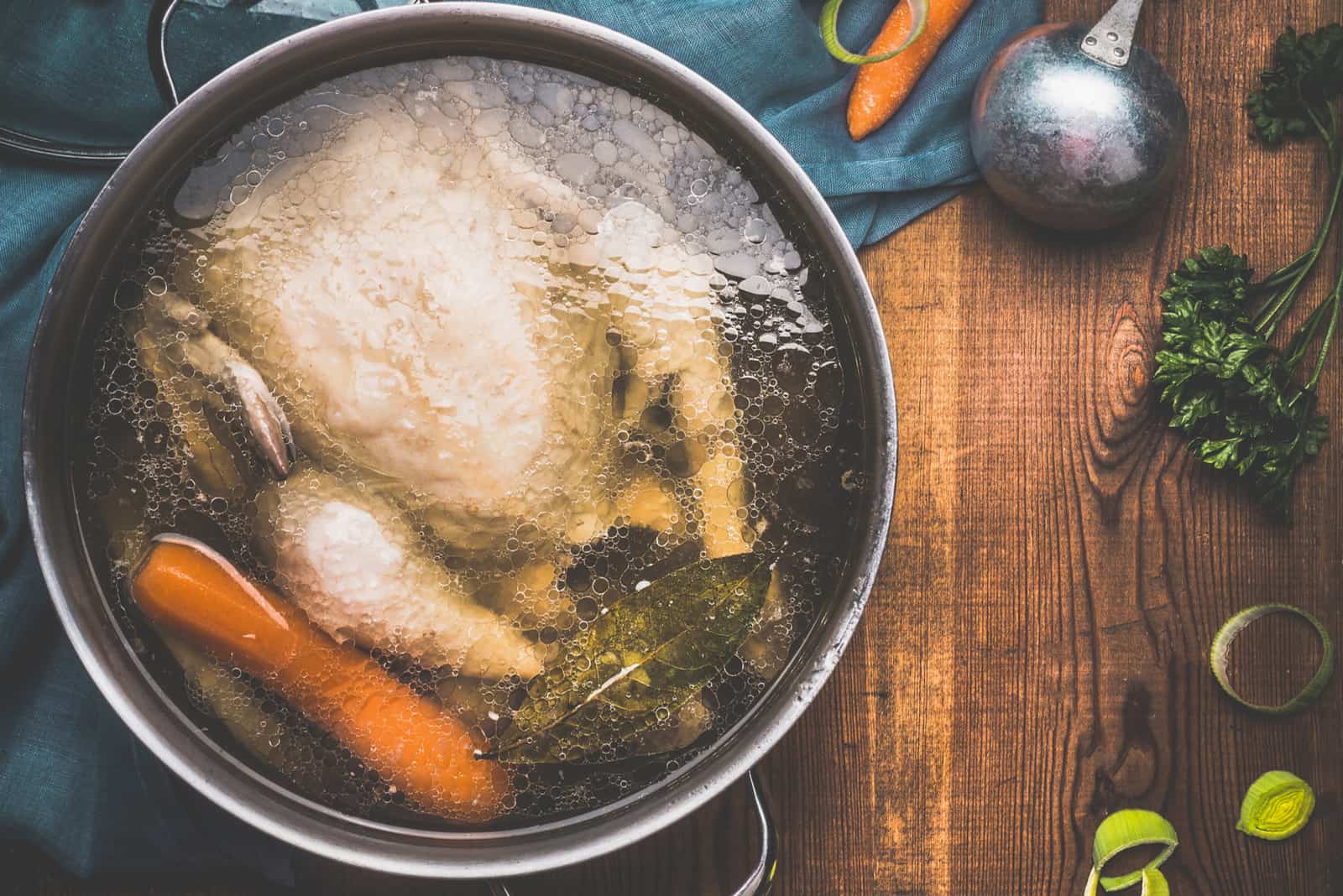There are many reasons why you would want to feed your pooch boiled chicken. Boiled chicken has the benefit of being a great addition to your pup’s diet, especially if it is free of hormones, additives, and other harmful ingredients.
Here, we’ll teach you how to boil chicken for dogs (and, more importantly, why).
Some dogs might suffer from an upset stomach due to digestive issues (some just have sensitive stomachs due to their dog breed or some other medical issue).
Other dogs might have special dietary needs and can benefit from eating what is the equivalent of chicken soup to their dog owners! Sick dogs overall can benefit much from munching on this tasty treat.
Boiled chicken can be a great source of omega 6 fatty acids, lean protein, glucosamine, and a variety of minerals and nutrients that all healthy dogs need.
This can help your dog have a more beautiful coat, hydrated skin, and healthier bones. There are lots of dog foods out there, but nothing can quite measure up to homemade dog food when it comes to benefits and taste.
It also doesn’t hurt when boiled chicken breasts fall into the category of dog treats! Even picky eaters will enjoy this treat; it’s just a favorite for most dogs.
Prepare your dog chicken and watch him or her devour it with much enthusiasm.
Now, let’s dive into how to boil chicken for dogs!
Some Disclaimers About Boiled Chicken For Dogs
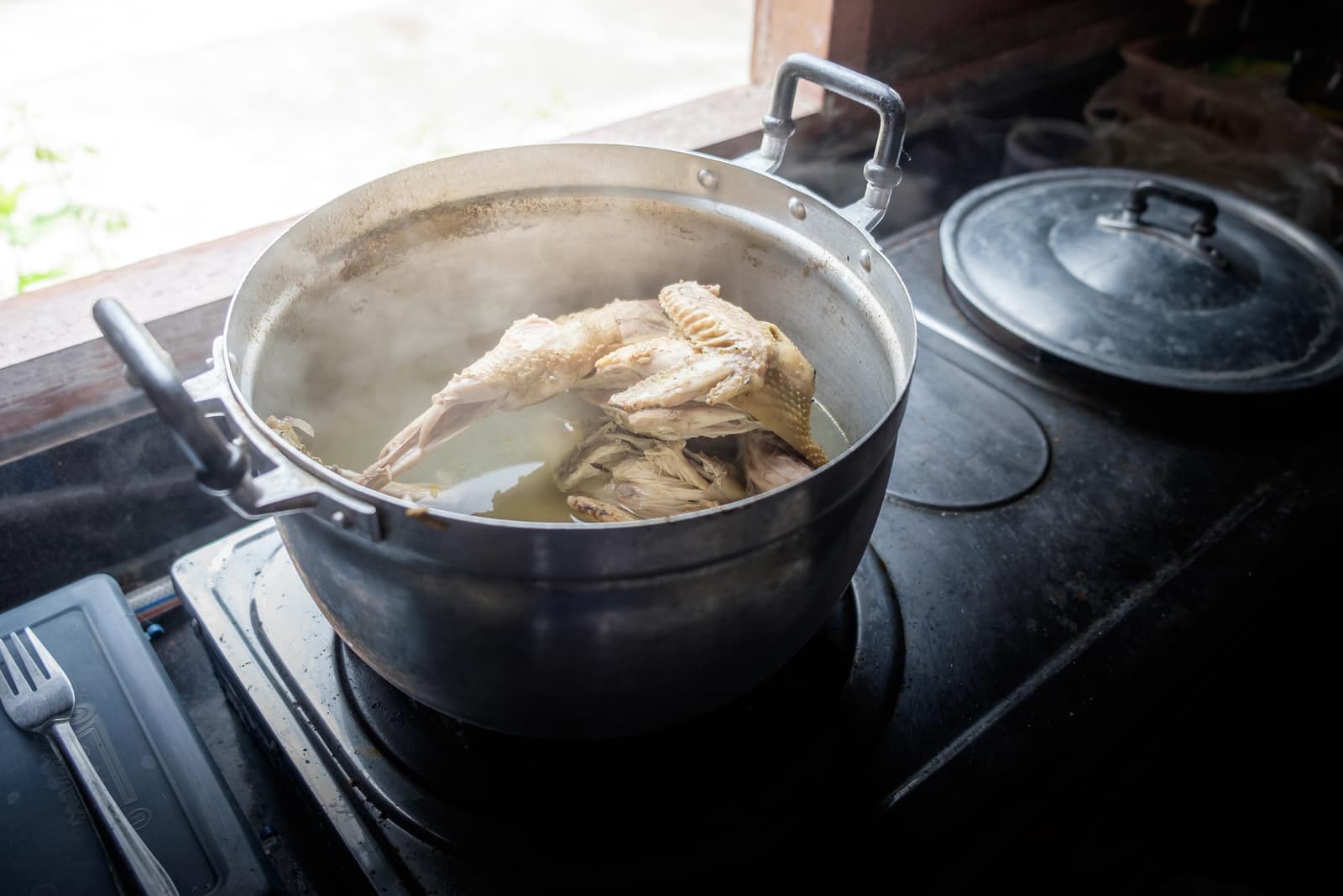
Although preparing some nutritious boiled chicken for your dog has many benefits, you need to know some things before preparing your dog this treat.
There are some risks associated with feeding your dog chicken, and the most important thing is to weigh out the pros and cons when it comes to tending to a dog’s needs.
Some things to keep in mind:
Prepare chicken breasts, which is healthier for your dog because it is low in fat.
We know that chicken thighs or wings are usually less expensive, but they contain more fat (and bone). You don’t want to take the risk of having the fat in chicken thighs increase your dog’s chance of getting pancreatitis.
Keep in mind that chicken is the third most prevalent food allergy.
If you think your dog might be suffering from a chicken allergy, remove it from their diet and contact your vet straight away, especially if you think he or she is having an allergic reaction.
Bones can be a choking hazard for dogs. They can puncture your dog’s stomach and intestines, so make sure that the chicken you prepare is boneless.
Plain chicken is best for your dog. Do not add any seasoning when you prepare your dog chicken breasts, as it can do more harm than good.
Besides, your dog likes the plain boiled chicken breast you serve to him or her, so don’t worry about the taste!
You must boil chicken breasts thoroughly before serving them to your pooch! There are risks associated with giving your dog raw chicken; a common one being salmonella or a variety of bacterial infections that both you and your dog don’t want to deal with!
Signs Your Dog Might Have Gotten Salmonella From Dog Food

Dogs don’t get salmonella very often, but if you are afraid that you might have given your dog undercooked chicken breasts, make sure to check for the following symptoms to weed out salmonella.
You want to make sure to look out for your dog’s health!
Some symptoms of salmonella in dogs include:
• weight loss
• lethargy
• diarrhea
• loss of appetite
• fever
• vomiting
How To Prepare Boiled Chicken For Dogs
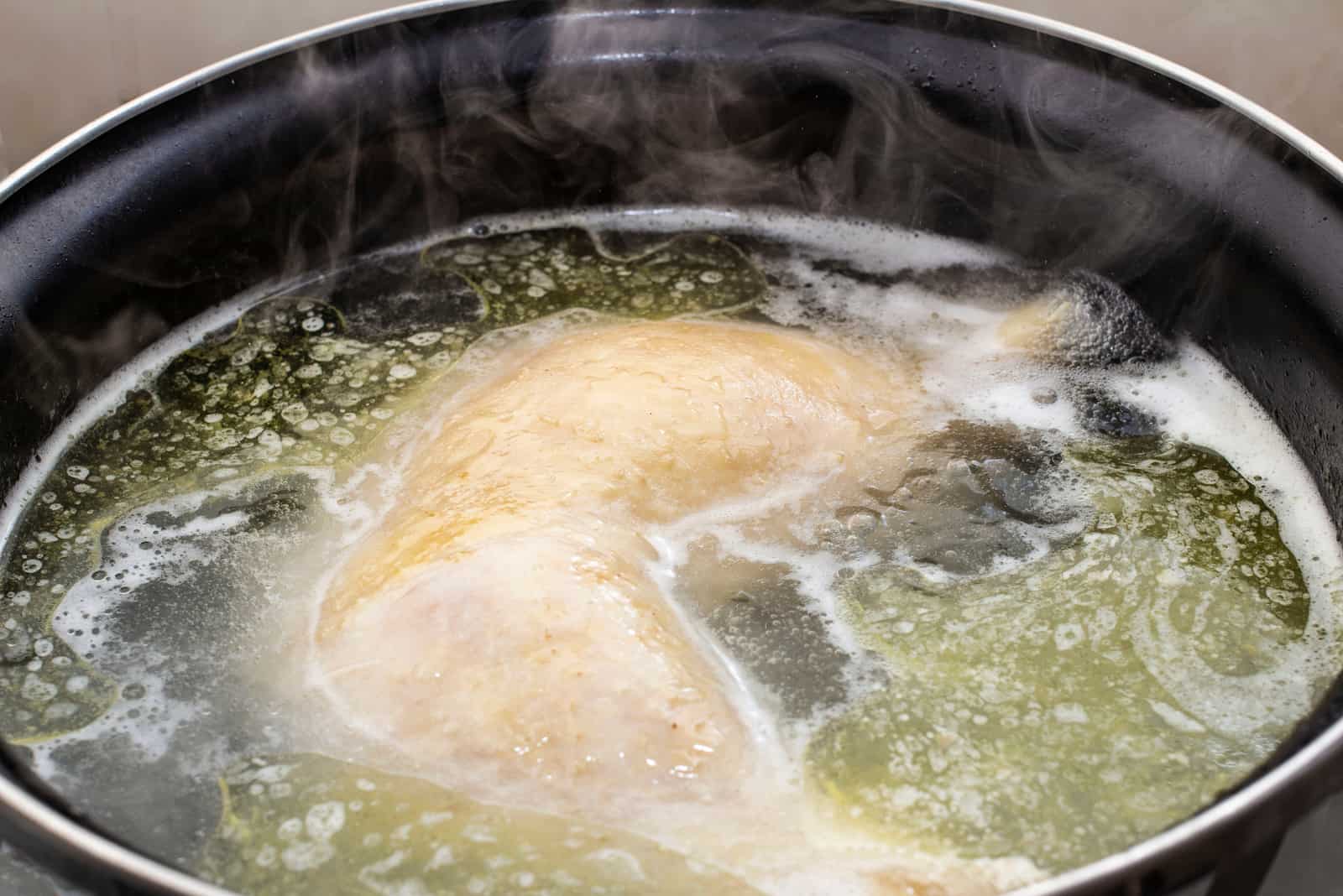
Like we said before, your pooch loves plain chicken breast with no seasoning, unlike their dog owners. For some reason (bewildering to us), they greatly appreciate this bland dog food. Kudos to them for enjoying a bland diet!
To prepare boiled chicken, you will need to prepare: 3 chicken breasts, water, a medium-sized pot, and a fork for shredding. Here is an easy, step-by-step summary of preparing your dog boiled chicken – the dog food recipe your pup will love!
Defrost chicken breasts. Make sure you completely defrost your frozen chicken in the fridge and not by soaking it in warm water or leaving it out in the open because that increases the chance of bacteria.
Avoid cooking semi-defrosted chicken because it affects the cooking time.
Clean chicken breasts so that they are skinless and boneless (some might have lingering bones, and we don’t want to risk a choking hazard). Skinless chicken breasts have less unnecessary fat, which is good for your dog’s health.
Place chicken breasts (now boneless and skinless) in a medium-sized pot with enough water. A good rule of thumb is leaving 2 inches of space at the top of the pot so that the water doesn’t accidentally boil over, causing a mess.
Cover the pot, bringing water to a boil
Boil chicken. The cooking time will be around 12 minutes after the water has begun boiling on high heat.
Always check that the meat is completely cooked (sometimes, the cooking time might exceed the 12-minute mark that we recommend). Remember, we don’t want to serve our dogs raw chicken!
If the chicken is gummy or pink when you inspect it by shredding it into pieces, it is still raw, and you need to cook it for a longer period of time.
Shred chicken into small pieces with a fork and let the chicken cool off for about 10 or 15 minutes so that you avoid giving your pooch burns.
We know that pups tend to be impatient when they see a great treat. Shredding chicken into small pieces removes the risk of a choking hazard and makes the chicken easier for your dog to digest.
You also might want to consider your dog’s size when shredding chicken. A larger dog can take larger bites whereas a smaller one might need a little extra help.
Feed your dog a small portion of the shredded chicken breast (check how much below), and store the rest as leftovers.
You can also pair the small pieces of boneless chicken breast with other dog foods like rice, certain veggies, or commercial dog food like kibble – a discussion we’ll get into in just a second!
Wait, Cooked Rice For Dogs?
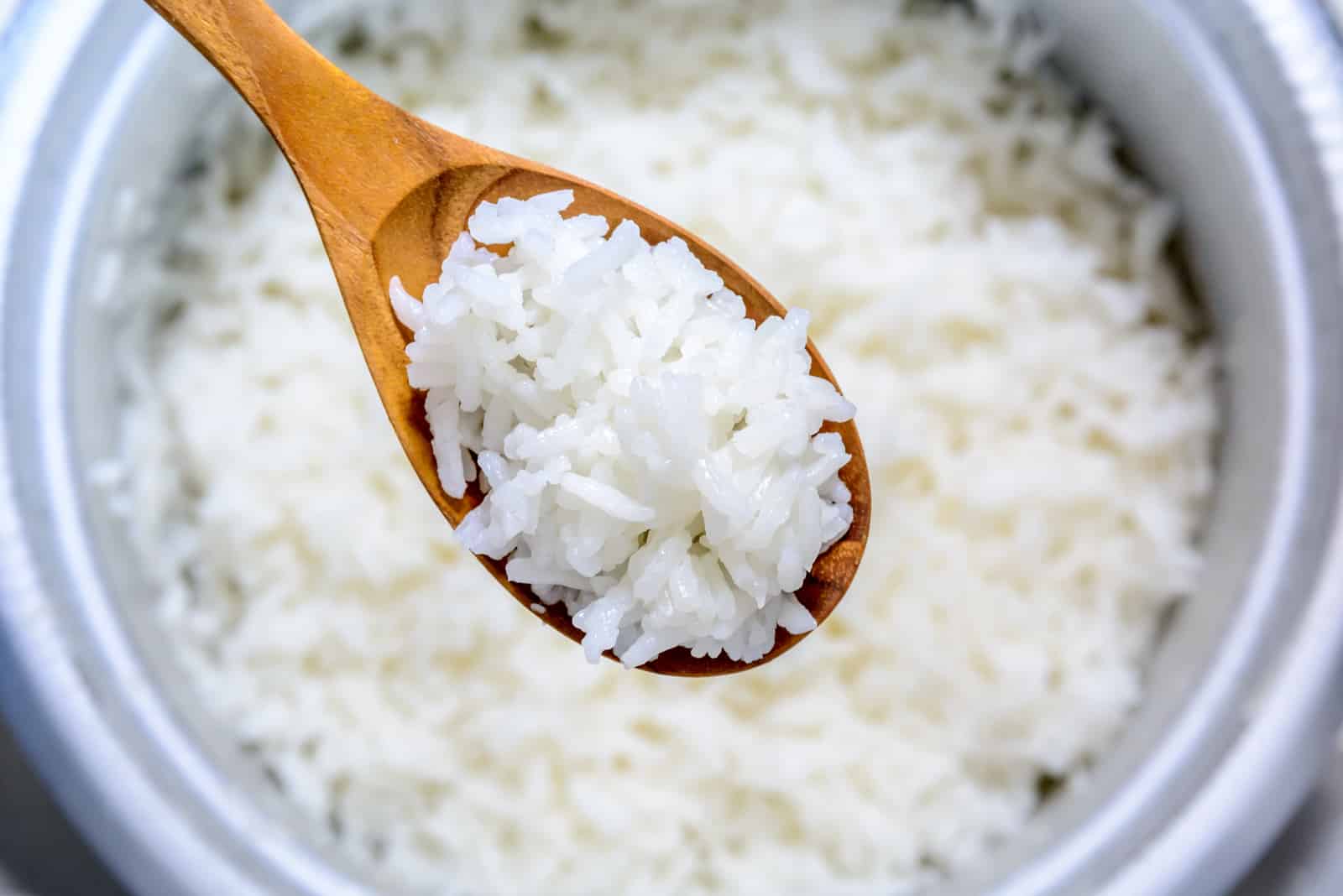
Yes, cooked rice can be unbelievably helpful to your dog’s digestive system, especially if he or she is prone to having an upset stomach. Usually, people feed their dog rice with boiled chicken to decrease the chance of them having digestive issues.
Also, it isn’t uncommon for commercial dog food to contain rice, so it isn’t too shocking that we recommend it. Your pup might be used to consuming rice in some shape or form by now.
Now that you know how to boil chicken for dogs, we can dig into the nitty-gritty of cooked rice.
Make sure you use cooked white rice and not brown rice if you are thinking about feeding rice to your dog. Brown rice is harder for dogs to digest, which defeats the purpose of giving your dog rice in the first place if your plan is to have your dog’s food more digestible.
Another great thing about white rice is that it is packed with carbohydrates, which are necessary for your dog’s diet.
Here is a short summary of why white rice is excellent:
• it is low in fiber, so if you prepare it with other veggies, it can add to a well-balanced meal
• high in carbohydrates, essential for your dog’s health
• fantastic for dogs with a sensitive stomach
• helps digestion
Preparation Of White Rice
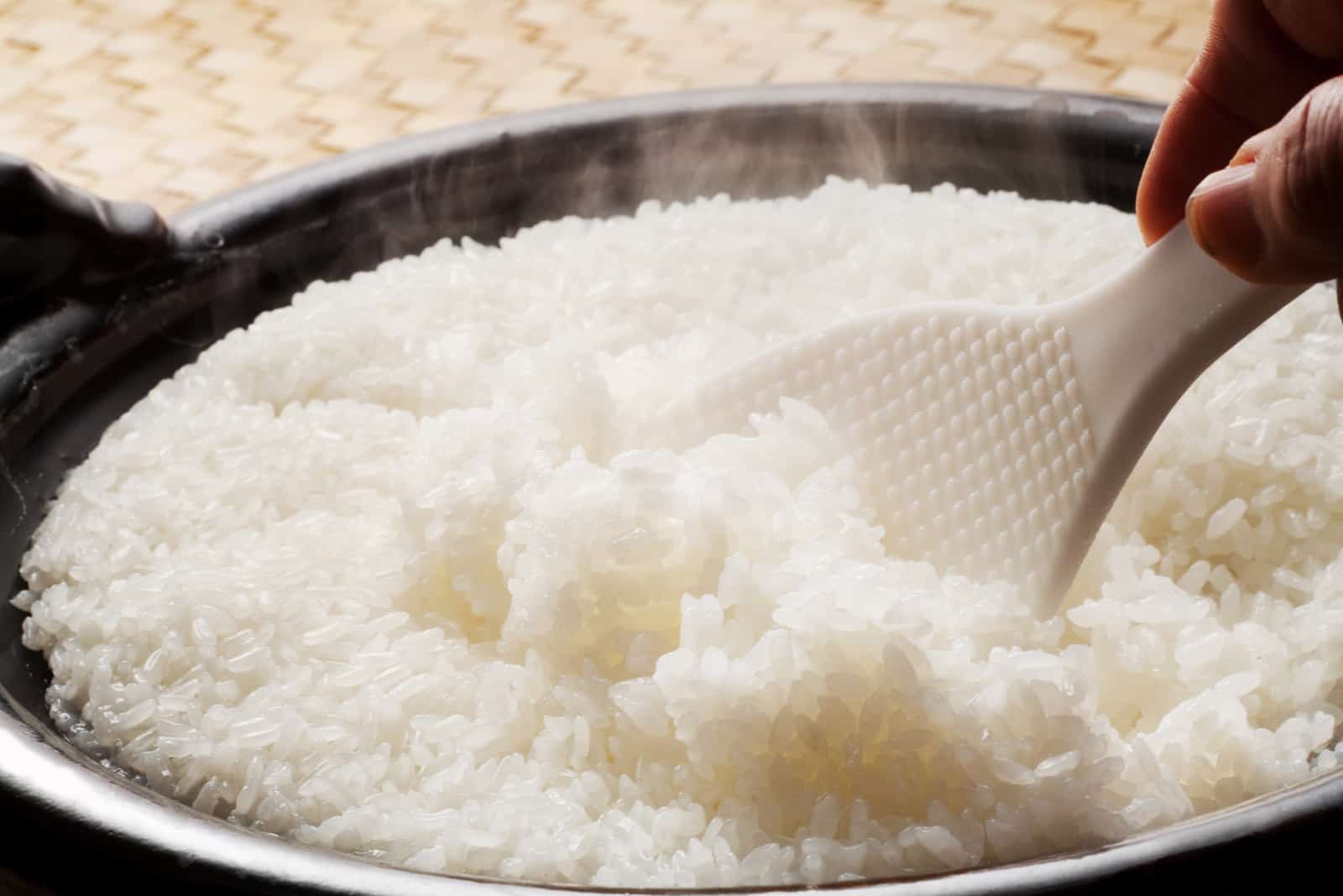
Preparation is easy: just make sure you prepare the white rice without any seasonings (remember, dogs love that bland diet!) and mix it with the boiled chicken.
If you really want to make the meal tastier, you can always add the chicken broth from the boiled chicken to the rice and cook the rice in it.
Or, you can add the chicken broth later on, making the mix tastier. In addition to the taste, the moist texture allows your dog to swallow the treat more easily.
Make sure not to add any veggies like onions or garlic to the meal because these things can be toxic to your healthy dog whether raw, powdered, cooked, or fried.
Also make sure to check which vegetables are good and bad for your dog. We’ve covered the good ones down below!
You should proportion the rice to chicken in a 2:1 or 3:1 ratio, so if you are preparing 2 cups (400 g) of cooked rice, you should prepare it with 1 cup (125 g) of cooked chicken.
Or, for a larger dog, 3 cups (600 g) of cooked rice should be prepared with 1 cup (125 g) of cooked chicken, for instance. Always consider the weight of your dog.
Here is a more detailed overview of how to prepare rice if you like following a step-by-step guide:
You should measure the chicken broth from the preparation of the chicken, as well as how much rice you want to prepare. You want to have a ratio of 1:2 of rice to water. This means that for every cup of rice, you need to add 2 cups of water.
Now, bring the broth to a boil.
After the broth starts boiling, you should add your rice.
Bring the mix to a boil and then allow it to simmer – you want to avoid the rice sticking to the pan because of high heat!
Cover the mix, allowing it to simmer for about 12 minutes.
You can always open and check how your rice is looking so far. You can tell that it is finished when the rice grains turn from pearly white to an almost transparent white color.
If there are brighter white grains in the middle of the rice, then it isn’t finished. Also, uncooked rice tends to have somewhat of a gummy texture.
And, viola, your rice is complete! Mix it with the chicken and you’re ready to serve it to your dog. Just make sure that it has cooled down before doing so.
When prepared this way, rice for dogs could prove to be quite beneficial to their sensitive stomachs.
Other Foods To Spice Up Chicken For Dogs
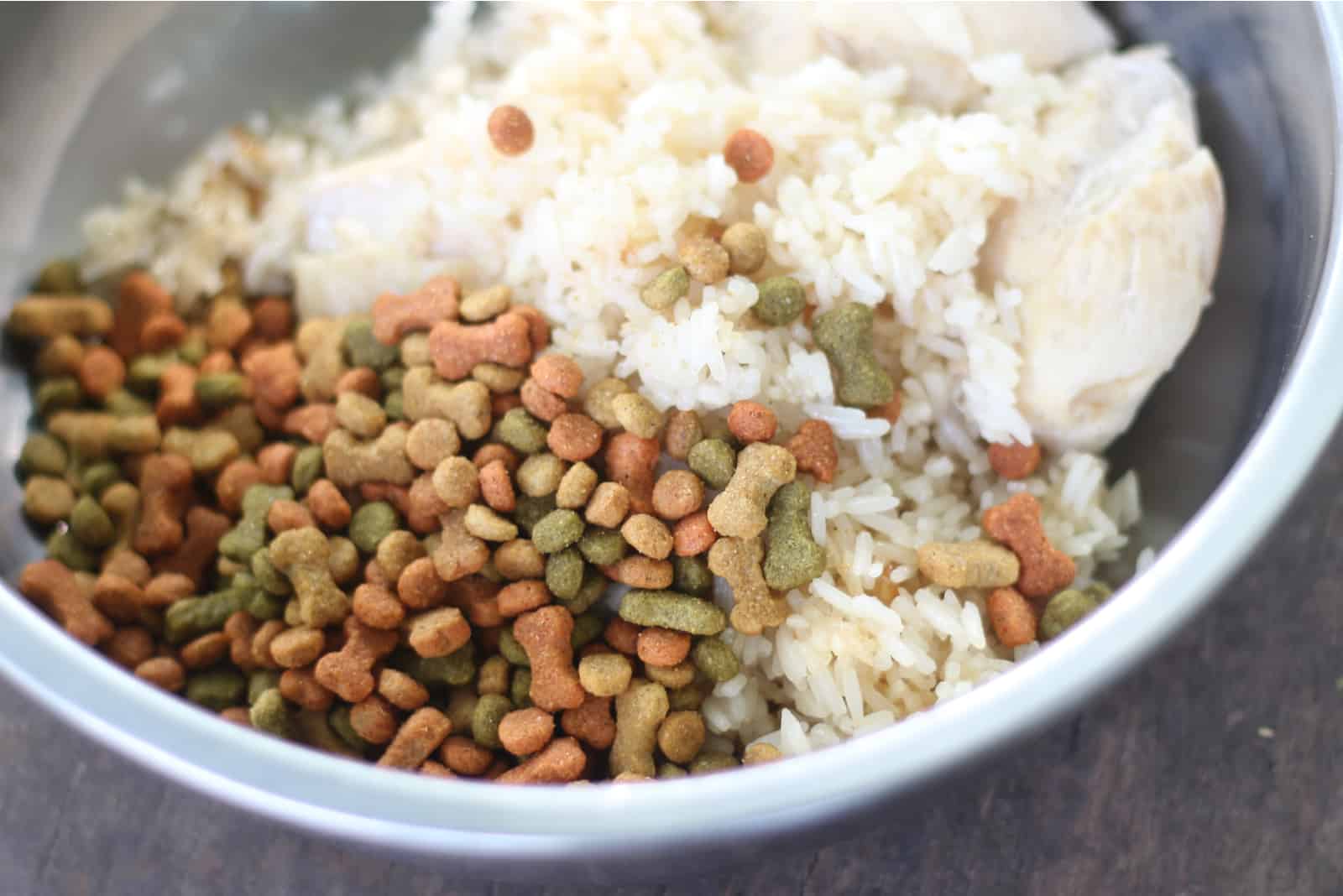
You know how to boil chicken for dogs and make some rice with it – but you’re thinking about adding other things to this treat? We’ve got you covered!
We do recommend that you only stick to giving a sick dog white rice and chicken (the simplest bland diet) because adding anything extra might cause further issues.
However, if you are thinking about adding extra things to your healthy dog’s diet, we’ve prepared a list of things you can consider adding to this tasty snack.
To enhance your dog’s diet, you can think about adding other ingredients that can make the meals more nutritional and healthy. Some of these things include:
Vitamin supplements
You can add supplements in powdered form to your dog’s meals. All you have to do is sprinkle the powder in your dog’s boiled chicken, mix, and voila!
Dog food
Mix the boiled chicken with your dog’s favorite wet or dry food for a tastier treat.
Some dogs that are picky eaters can be coaxed into eating the boiled chicken if you add the kibble that they are used to in this new food if they are uncertain about it at first.
Cooked veggies
You can add some veggies such as artichokes, broccoli, green beans, or carrots to add fiber to your dog’s meal as long as it is under 10% of the meal in order to avoid digestive issues.
Carrots, in particular, are great because they are tasty and low in calories.
Other benefits include a high vitamin A, K, and potassium content, and the fact that they are great for a dog’s dental health when given to them raw.
Please make sure to thoroughly clean and wash the vegetables you are using in order to prevent any unwanted dirt or pesticides from being consumed by your pup!
Peanut butter
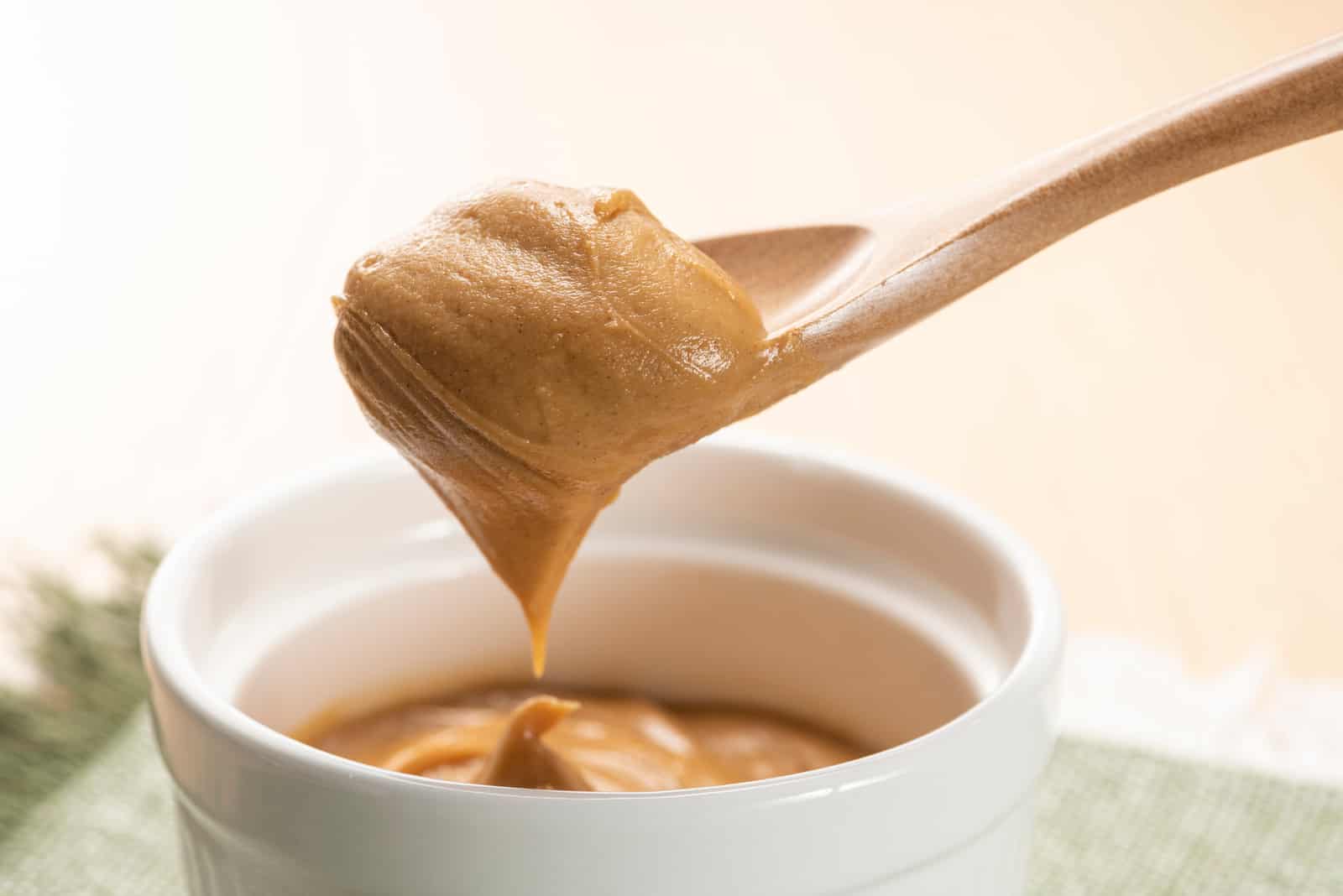
Peanut butter can be an excellent addition to your dog’s diet when consumed in moderation, as it isn’t the healthiest option. It can be a great source of protein and good fats, and it contains vitamins B and C.
Make sure that the peanut butter you give your dog is unsalted, has few sugars, and doesn’t have additives, which can all harm your dog’s health.
If you want to be extra certain that the peanut butter you are giving your dog is good, you can opt for making your own to ensure none of these additives become part of your dog’s nutrition.
Canned pumpkin
Canned pumpkin acts as a great source of a variety of nutrients and fiber, which can aid your pup’s digestion.
It contains many great vitamins, such as vitamins A, C, and E. It is also packed with prebiotics, which are fantastic for digestion in addition to the high fiber content.
Make sure you are only serving plain canned pumpkin without any additives and extra sugars.
You can give your dog one teaspoon of canned pumpkin for every 10 pounds (4.5 kg) of weight.
Plain yogurt
Plain yogurt can be used as an ingredient to enhance your dog’s protein and calcium levels, all of which are necessary for your pup’s health
Another thing to know about add-ons!
Make sure to check with your vet before adding these things to your dog’s diet. If you sense that your dog isn’t digesting some of these things well, he or she might be having an allergic reaction, and it is always wise to check with your vet to make sure.
You also don’t want to risk unbalancing your dog’s nutrition without the advice of an expert.
There is such a thing as too much of a good thing, and good food is no exception! Sometimes, you can unbalance a healthy dog’s digestive system if you give him or her too much or too little of something.
After all, you wouldn’t want anything you add to your dog’s diet to make him or her sick – it’s always wise to shift your focus to what your dog needs.
Every dog’s needs can be different depending on a variety of factors, such as dog breed, health issues, etc.
How Often Can I Feed Cooked Chicken Breasts To My Dog?
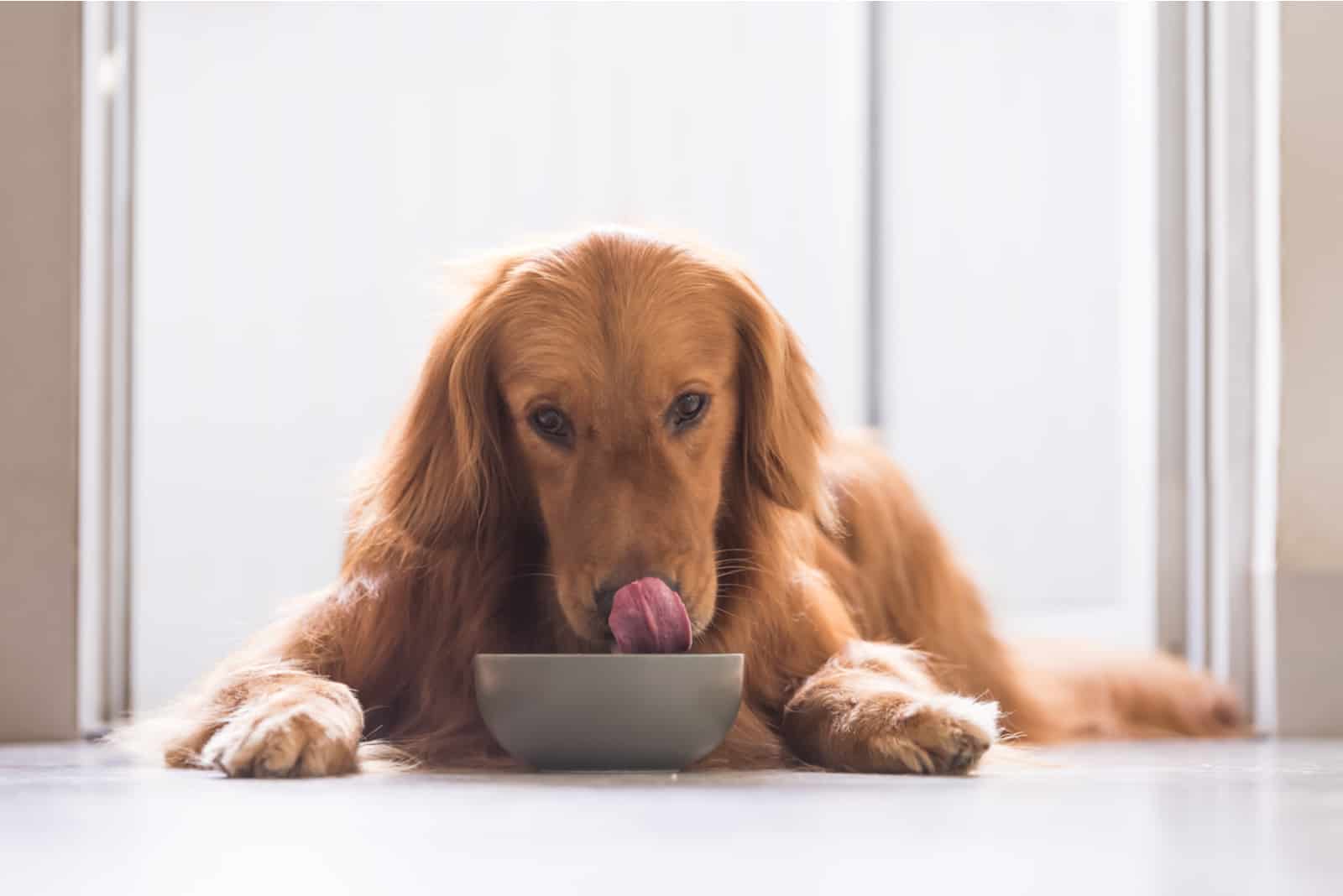
Chicken is often found in dog food, so feeding your dog chicken every day is perfectly fine, but there are some things you as a dog owner should know.
If you are only giving your dog cooked chicken for the time being because it is sick, you don’t have to worry too much about how much cooked chicken for dogs is safe because it doesn’t apply to your case.
If you are concerned that your dog will start rejecting other foods by becoming too reliant on this treat because of his or her love for it, you can limit the chicken meals to once or twice a week.
However, if you are giving your dog boiled chicken every day as its main dog food source, you should know that even though chicken is very high in protein, your pooch still needs additional vitamins and minerals like potassium, zinc, iron, calcium, and many others.
A good idea would be to double check with your vet regarding what other supplements would be good for your dog in addition to the cooked chicken as your dog’s main food source.
How Much Boiled Chicken Should I Give To My Dog?
That would depend mostly on how big your dog is. Many vets would recommend feeding your dog approximately 1/4 or 1/3 cup of meat protein per 20 pounds (or 9.07kg) of your dog’s weight in a day.
However, you don’t want to push your luck when you first start giving your dog boiled chicken as dog food. Start out small just to make sure your dog doesn’t have a chicken food allergy that would upset his or her sensitive stomach.
Can My Dog Get Allergy Tests Done?
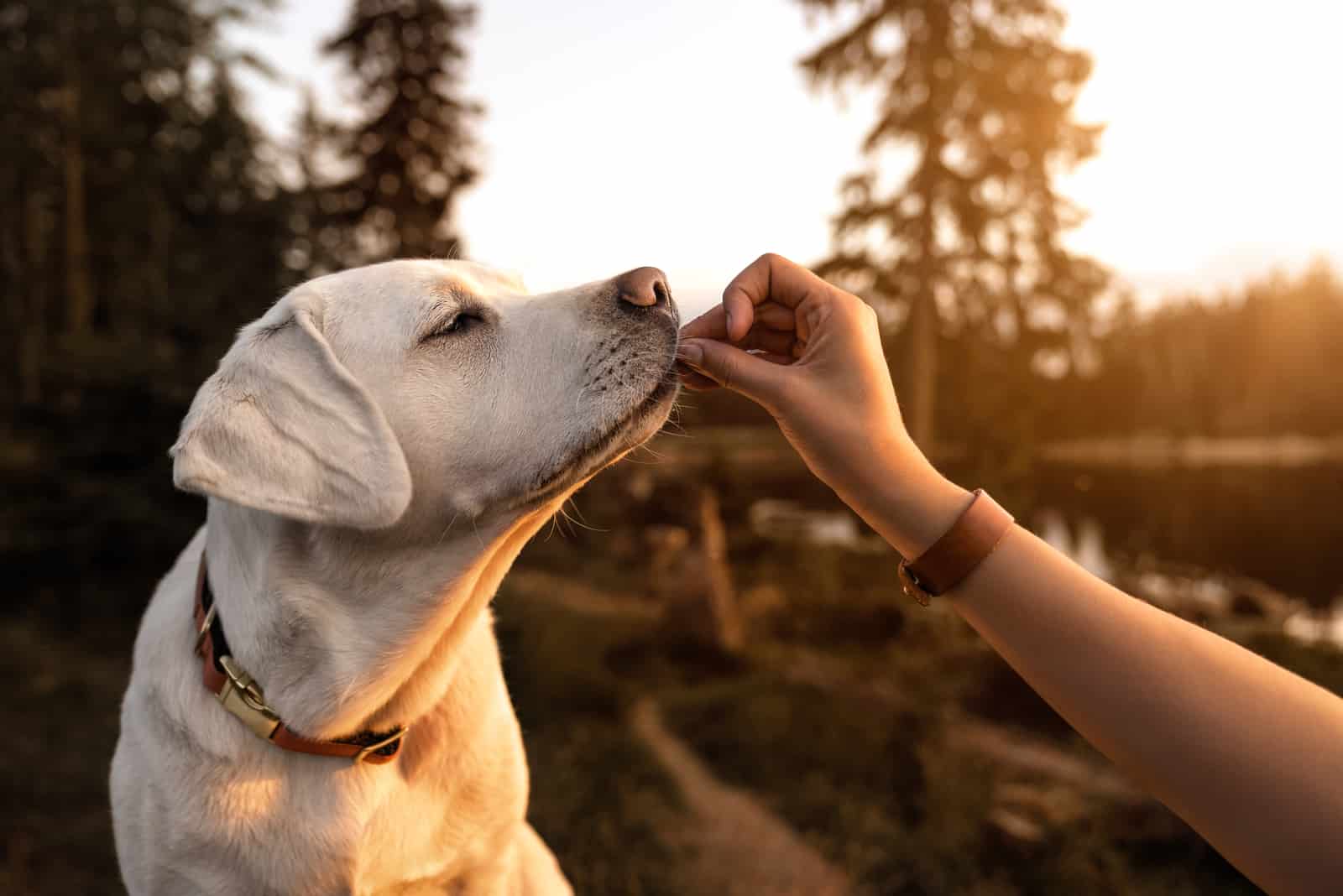
Most vets would recommend doing the elimination diet where you entirely remove specific foods one by one from your dog’s diet to see if he or she will develop a positive reaction from removing that food.
This is also a less expensive form of discovering a food allergy. This process usually lasts from two weeks to two months in order to see if any symptoms persist.
If symptoms continue, you will know that the food is causing your dog an allergic reaction or discomfort. You should then proceed to eliminate the food once and for all.
If your dog is feeling very uncomfortable or sick, this might be a hassle, so what you can do instead is ask your vet to administer an IgE serum test for a proper diagnosis in order to see what might be going on with your dog’s blood.
You might very easily discover some allergies by taking this blood test, which can be beneficial to know as a dog owner.
How Can I Tell If My Dog Is Having A Food Allergy?
Like we have established, dogs can have food allergies, so it is a great idea to know what you are looking for if your dog is displaying any negative reaction to boiled chicken (or other foods in general like eggs and beef, which are also common food allergies for dogs).
If you notice your dog is reacting in a strange way, know that diet can be a reason.
There are many different tell-tale signs that your dog might be having a reaction to food. Some of them include:
• an upset stomach: you want to check if your dog is vomiting, lacks an appetite, or has diarrhea
• itching: some allergic reactions can cause hives or bumps, which will make your dog relentlessly scratch himself or herself at their ears, stomach, or paws
• face swelling: this is a more serious allergic reaction that can affect a dog’s eyelids, lips, or ear flaps
What About Baked Or Grilled Chicken For Dogs?
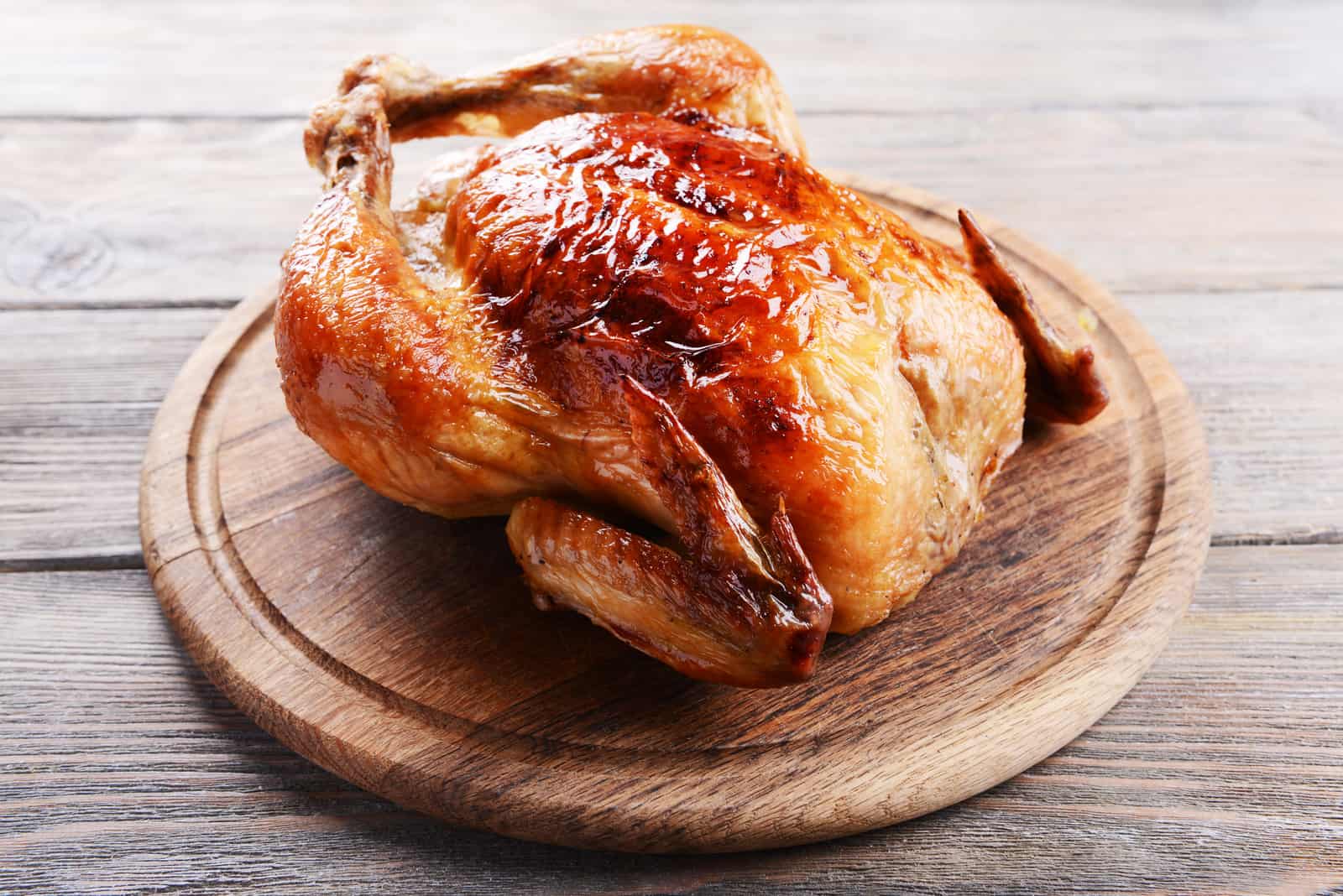
Enough about boiling chicken – I know how to boil chicken for dogs now, thanks! But, what about grilling or baking chicken? Can I feed my dog chicken if it has been prepared in a different way?
Well, there is a reason why we emphasized boiled chicken above all other kinds of prepared chicken.
Boiled chicken has the benefit of not containing much fat as opposed to other preparation methods – so it definitely makes for a healthier option.
Even though you can grill and bake chicken, we will always claim that boiling chicken is the best option (plus, it takes less time than other ways of preparing chicken).
But, we will discuss other ways to cook chicken for your dog for you foodie dog owners who enjoy preparing food in different ways!
Baked Chicken
Since you know how to boil chicken for dogs, you should know that there is not much of a difference when it comes to preparing baked chicken as opposed to boiled chicken.
Make sure that you clean your chicken the same way you would if you wanted to boil chicken, and place the chicken in an oven-safe container with some oil to avoid it from sticking.
Then, place it in a preheated oven at high heat (400°F (204.44°C) should do the trick!).
The cooking time should be around 20 to 30 minutes, depending on your kind of oven, and like always, make sure that the chicken you use is boneless, skinless, and thoroughly cooked before serving it to your dog.
After baking, shred the chicken like you would boiled chicken, and add any of the additional ingredients mentioned above before feeding it to your dog.
Grilled Chicken
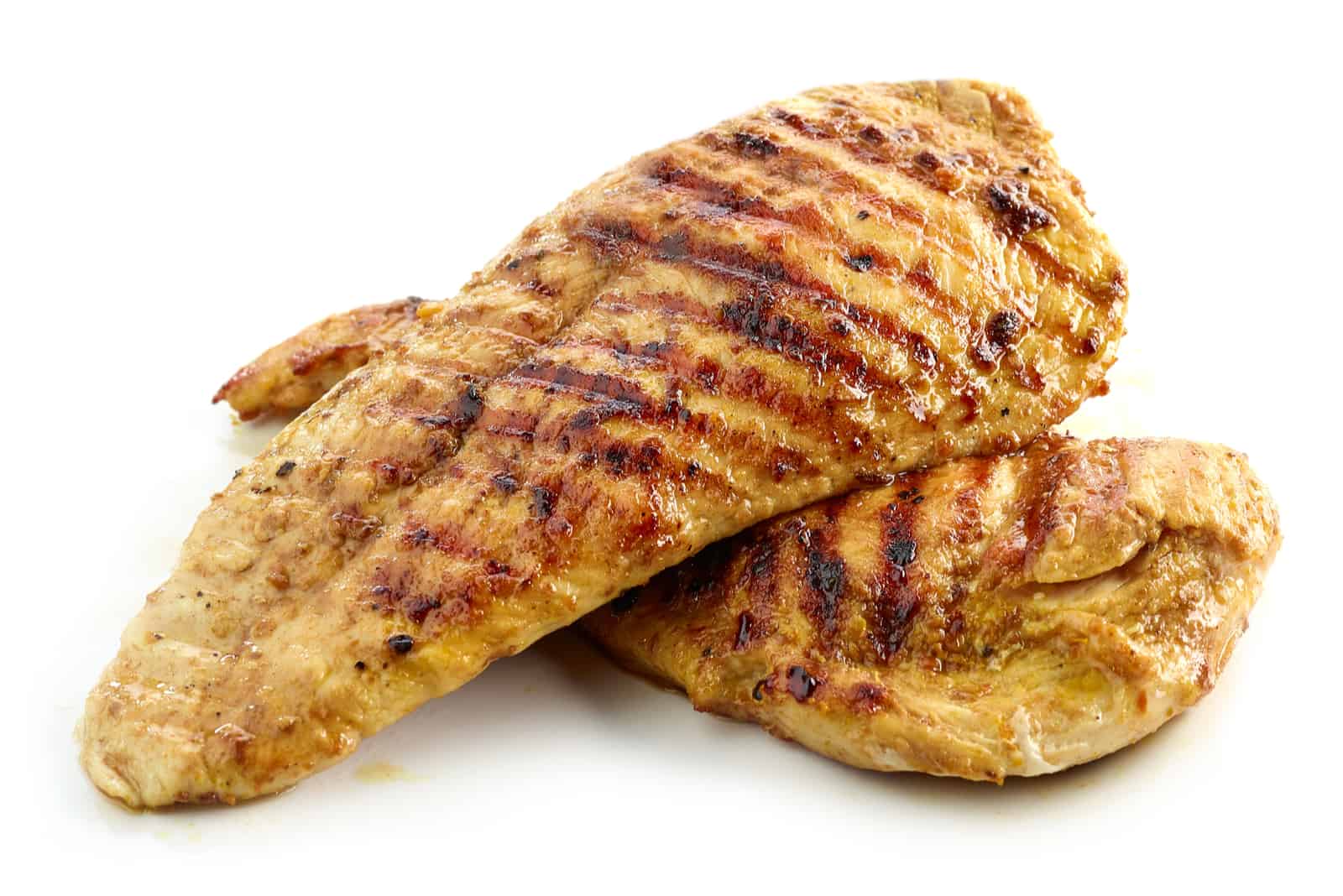
You can also grill the chicken you have prepared, and it will still be a healthier option than fried chicken, which uses a lot of fat.
You want to make sure you grill your chicken on high heat in order to kill any unwanted microbes, and please avoid seasoning – remember, we might like it, but our dog’s digestive system definitely does not!
How Long Can I Use Leftover Boiled Chicken?
If you choose the option of feeding your dog cooked chicken every day, you might succumb to the temptation of making enough to last a week so that it is easier to manage for feeding time, but we’ll advise against that.
Boiled chicken typically lasts for about three to four days in the fridge, and even though you might be tempted to stretch that out, bacterial infections are no fun for your dog or you as a dog owner.
But, we get it – sometimes it can be frustrating to prepare boiled chicken all the time, especially when you don’t have the time for it!
What you can do instead is freeze the boiled chicken so that it can last for months. Just make a larger batch and freeze away!
Just remember to leave the chicken to thaw in the fridge before serving it to your dog!
Final Thoughts
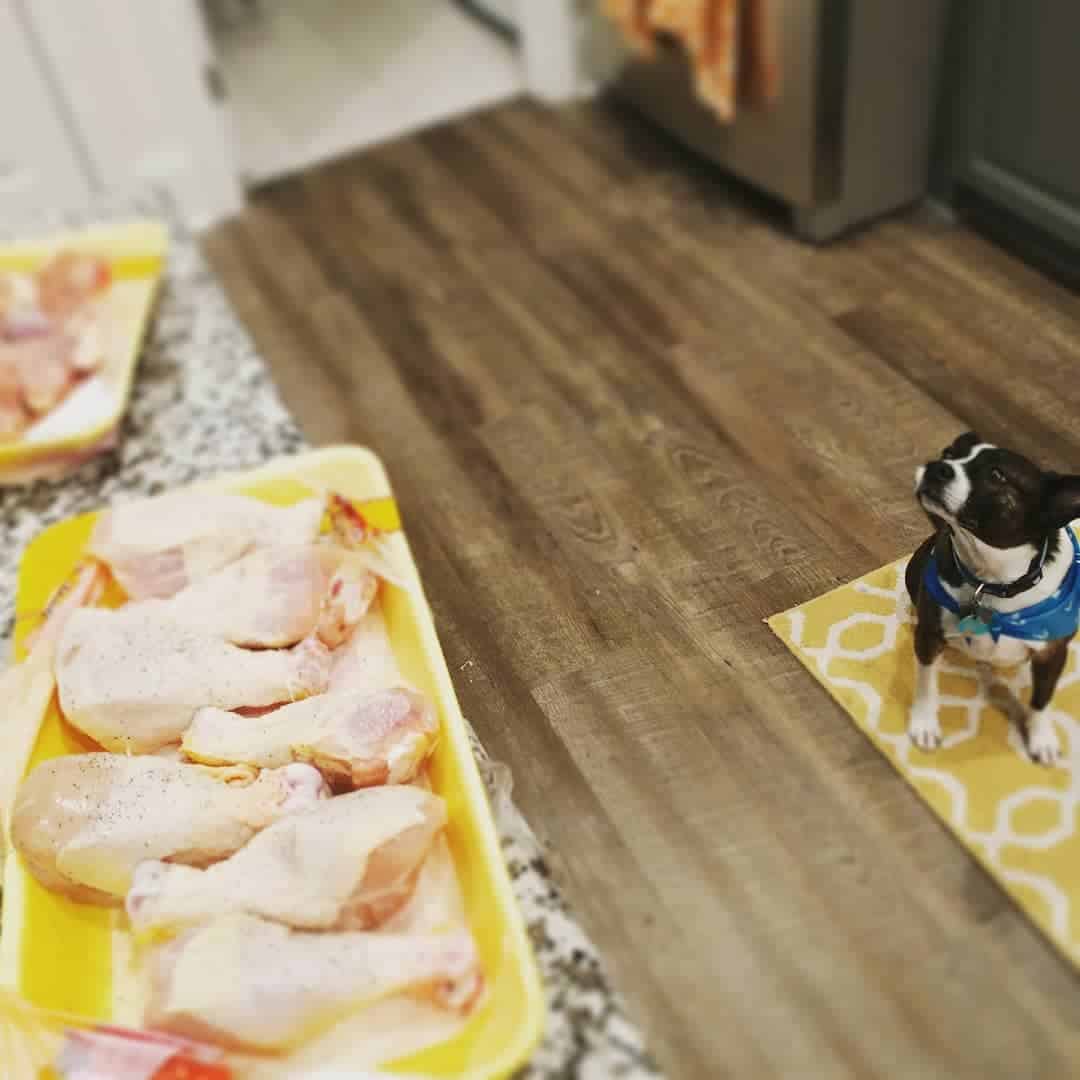
Photo from: @thedog_finn
Now you know how to boil chicken for dogs! We’ve established that it can be a nutritious food source for your pup, so it’s time for you to go out of your way and make some for your furry friend!
If you are still interested in learning more about how adding cooked chicken (or any of the other listed foods) affects your dog’s diet, you can always consult your vet and make the best decision for you and your pup’s needs.
Otherwise, after you have made this tasty treat, you can teach your friends how to boil chicken for dogs, too!
Read Next:
How To Keep Ants Away From Dog Food: Handy Tips And Tricks
How To Make Puppy Mush + 3 Recipe Ideas To Make It Yummier
